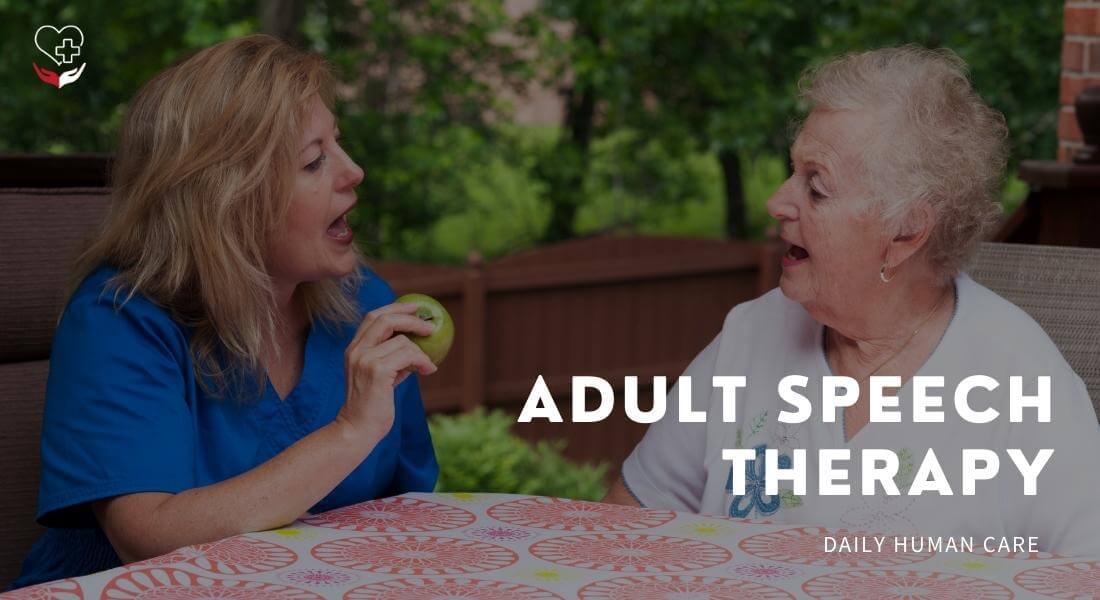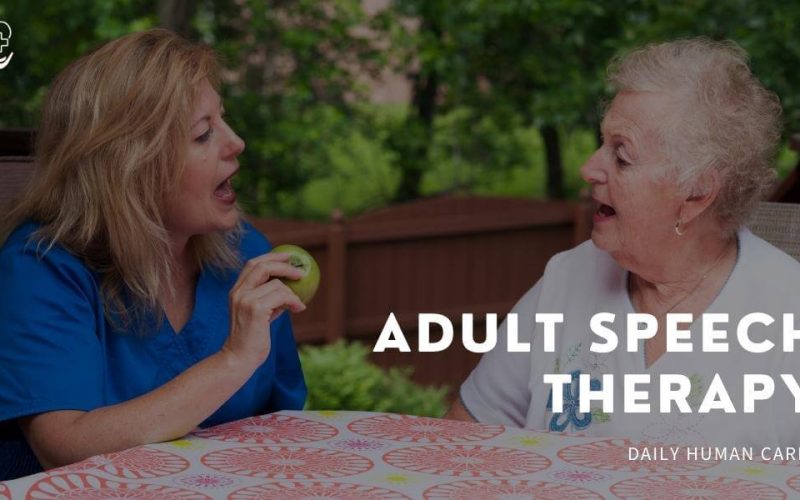In this Article we are going to discuss What is Speech Therapy and What happens In Adult Speech Therapy?
Table of Contents
What is speech therapy?
Speech therapy is concerned with diagnosing and treating people who have issues with their ability to communicate effectively due to issues with their speech. Speech-language pathologists (SLPs), often known as speech therapists, are the people who carry out this therapy.
Improved communication can be achieved through speech therapy. Therapy for specific types of speech and language disorders may involve articulation therapy or language intervention activities.
An adult who has suffered a stroke or other brain injury and now has difficulty speaking may benefit from speech therapy.
You require speech therapy, but why exactly do you need speech therapy?
Speech therapy can be used to address a wide range of issues of the speech and language.
- Articulation disorders. The inability to correctly produce specific word sounds is known as an Articulation disorder. A child with this speech problem may drop, switch, distort, or add word sounds to their sentences. An example of distorting a word would be saying “thith” instead of “this”.
- Fluency disorders. Having a fluency impairment impacts speech in a variety of ways, including how quickly and smoothly it is produced. Fluency issues include stuttering and cluttering. A person who stutters has difficulty uttering a sound, and their speech may be interrupted or blocked, or they may repeat part of a word. Cluttering is characterized by rapid speech and the blending of words.
- Resonance disorders. When the vibrations responsible for voice quality are altered by a blockage or obstruction of regular airflow in the nasal or oral canals, we have a resonance problem. The velopharyngeal valve may not close properly, which can potentially cause this. Cleft palate, neurological problems, and enlarged tonsils are all common causes of resonance disorders.
- Receptive disorders. This condition affects the ability of people to understand and digest what others are saying. A lack of interest in what someone is saying, difficulty following orders, or a limited vocabulary can result from this. Receptive language impairments can be caused by other language abnormalities, autism, hearing loss, or even a brain injury. Autism, hearing loss, and head injuries are all possible causes.
- Expressive disorders. Information is difficult to convey or express if you have expressive language disorder. People with expressive disorders may have difficulty creating correct sentences, such as utilizing the erroneous tense of a verb when they speak. Down syndrome and hearing loss are only a couple of the conditions it’s linked to. Head trauma or a medical condition might also cause it.
- Cognitive-communication disorders. Cognitive-communication disorder refers to difficulties in communicating because of an impairment to the region of the brain that governs your ability to think. It can cause problems with memory, problem-solving, and communication. A brain injury, stroke, or abnormal brain development can all be factors in the development of autism.
- Aphasia. People who suffer from this type of communication problem have difficulty speaking and comprehending what others are saying. It can also affect a person’s reading and writing abilities. The most common cause of aphasia is a stroke, however it can also be caused by other types of brain problems.
- Dysarthria. As a result of an inability to control the muscles required for speaking, this disorder, dysarthria, results in slurred speech. Multiple sclerosis (MS), amyotrophic lateral sclerosis (ALS), and stroke are the most prevalent causes of facial paralysis or weakening of the mouth and tongue.
What happens in speech therapy?
In most cases, a speech-language pathologist (SLP) will conduct an evaluation to determine the nature of the patient’s communication problem and the most effective treatment.
Speech therapy for children
Depending on the type of speech disorder your kid has, speech therapy may be conducted in a classroom, a small group, or one-on-one with your child. Depending on your child’s illness, age, and needs, speech therapy exercises and activities will differ. If the SLP is working with a youngster, she or he may do the following:
- As part of a language intervention approach to enhance language development, chat and play with books, drawings, and other materials teaching a youngster how to pronounce specific syllables and sounds through age-appropriate play
- Educate the youngster and the parent or guardian on how to conduct their own at-home speech therapy sessions.
Adult Speech therapy
A comprehensive evaluation is the first step in adult speech therapy as well. Adults who participate in speech therapy exercises can improve their speech, language, and cognitive abilities.
Patients with swallowing difficulties due to an injury or medical condition may also benefit from swallowing retraining as part of their treatment.
Activities include:
- cognitive communication activities such as problem solving, memory, and organization
- strategies for bettering one’s ability to interact with others
- resonant breathing exercises for oral muscle strengthening
If you’d like to try some adult speech therapy exercises at home, there are a variety of options available, including:
- Workbooks,
- games, and
- apps for the development of language skills in the context of speech therapy.
How long do you need speech therapy?
Several factors influence the length of time that a person will require speech therapy, including
- age
- the severity of the speech disorder.
- medical condition’s treatment frequency
- treating a medical condition that is causing these symptoms
It’s possible to have a speech disorder in childhood that improves over time while others require long-term treatment and maintenance.
Some medical conditions can lead to communication difficulties that improve with treatment and improvement in overall health.
Also Read : Speech therapy CPT codes
How successful is children and adult speech therapy?
Speech therapy’s success rate varies depending on the condition being treated and the patient’s age group. The timing of your entry into speech therapy can have an effect on the final outcome as well.
For young children, speech therapy has been most effective when started early and practiced at home by a caregiver.
What Happens in Adult Speech Therapy?
Your entire day is spent communicating, from when you get up in the morning to the time you fall asleep at night. You are constantly involved in linguistic and cognitively demanding activities, whether you are speaking, writing, reading, or listening.
The ability to understand what others are saying and express yourself through language is a natural part of many people’s lives. These tasks are complicated for millions of people in the United States, however, due to a variety of speech and language disorders.
Adults may seek speech therapy after a stroke, when diagnosed with a neurodegenerative disease like Parkinson’s disease or dementia, as well as to improve articulation and fluency in order to regain confidence in their communication skills. Adults may also opt for additional services, such as accent neutralization or assistance with public speaking, to improve their communication skills. You can rely on us to shed light on the inner workings of adult speech therapy.
Common Speech Disorders Requiring Adult Speech Therapy
Communication disorders affect approximately 40 million people in the United States. These conditions have an impact on your ability to express yourself verbally and acoustically as well as how you interact with others.
Speech production necessitates the coordination of a wide range of factors, including:
- Organizing your thoughts and remembering them
- focusing on what you’re hearing and processing it
- Searching for words
- Putting words in the correct order in a sentence
- The ability to speak clearly and loudly by synchronizing breathing and phonation.
- Prosody and tone are tools for expressing feelings.
- Planning and executing a sound production strategy for one’s voice
Speech language pathologists (SLPs) can help with the following three common disorders during adult speech therapy.
Aphasia
You can suffer from Aphasia, an acquired, neurological language disorder, if you are unable to understand or express your thoughts in written or spoken form.
It is possible for adults with brain damage to develop aphasia, such as TBI and CVA, brain tumors, and other neurological diseases.
In terms of severity, there are numerous types of aphasia. Even a minor problem can have a significant impact on quality of life. These include: Broca’s non-fluent, Wernicke’s (fluent) Aphasia, as well as global aphasia. Depending on your diagnosis, you may have difficulty understanding what other people are saying if they speak too quickly or in a group setting, or you may have difficulty retrieving words.
Apraxia
It is possible to develop acquired apraxia of speech following a neurological injury, such as a CVA, or from a progressive condition, such as dementia, which affects the brain. It is a motor speech disorder, which means that the brain struggles to plan and sequence the motor movements needed to speak. Interrupting the flow of communication is as simple as not moving your tongue, lips, or jaw in response to what you want to say.
As a result of apraxia of the verb, you may have difficulty starting a sentence, making mistakes, or omitting or adding sounds, as well as difficulty initiating words (i.e., trying to move your lips, jaw, and tongue to make a particular sound but not quite being able to do so accurately).
Dysarthria
As a result of brain damage, people with dysarthria develop a disorder in their motor speech abilities. People with dysarthria may have difficulty speaking clearly and loudly because of the way it affects their respiration, voice, and articulation.
CVA, Parkinson’s disease, atypical parkinsonism, amyotrophic lateral sclerosis (ALS), Huntington’s disease, and multiple sclerosis can all cause this neurologically-based speech disorder (MS). Your speech may be slurred, mumbled, too fast, or slow if you suffer from dysarthria. A lack of clarity can make it difficult for people with dysarthria to engage in social activities like talking on the phone or meeting up with friends.
Adult Speech Therapy Techniques
Many factors influence the techniques, methods, and intensity of your therapy. Your clinician will conduct a battery of tests on you in order to establish a baseline and gain a better understanding of your current situation and future goals. A variety of factors influence your prognosis for recovery or improvement, including your medical history, strengths and weaknesses discovered during the evaluation process, responsiveness to tried-and-true therapy techniques, and more. After that, they’ll devise a strategy to assist you in reclaiming your life, sharpening your communication skills, or enhancing your presentation.
There are a variety of ways to address these issues during adult speech therapy, but they all revolve around the same fundamental principles of neuroplasticity and motor learning. Practice, repetition, and salience are the keys to improving current skills or reviving an old one.
You will be given exercises that are specifically designed to help you reach your individualized goals in a particular treatment mode (e.g. intensive). So that the therapeutic gains you make can be applied to all areas of your life, in addition to just your professional life, you will practice these skills both at work and at home. The ultimate goal of an intensive program or speech therapy is to transfer the skills learned to your professional, personal, and favorite hobbies.
Adult Speech Therapy Exercises
When you leave a session, your work with a speech therapist isn’t done. If your speech language pathologist has given you exercise recommendations, follow them to the letter. Even if you’re frustrated, keep a positive attitude and be willing to participate. It’s important to remember that your SLPs are there to lend a helping hand and share their knowledge and experience.
In adult speech therapy, there is no one-size-fits-all approach. Some examples of how exercises can be used to treat these conditions are provided:
Stroke Recovery Rehab
If you have had a stroke, your SLP may use a combination of drills and functional activities to help you regain your ability to communicate effectively after the event. Work on your attention and memory by utilizing cognitive exercises like visualization techniques. Work on your vocabulary and word retrieval by performing tasks that require you to generate new sentences.
You can also participate in practical activities like role-playing conversations or preparing functional tasks to help you regain your self-confidence in your professional and personal responsibilities…
Your weekly online and in-person time commitments will range from 5 to 10 hours, depending on your personal preferences. Exercise, activities, relaxation, rest, and other recommendations are included in the schedule.

Improving Voice, Fluency, and Articulation
Exercises that help you speak more clearly and be better understood are the focus of this section. Vocal cord lesions and muscle tension are two common medical causes of voice problems. It is important to discuss your symptoms and medical history first with your otolaryngologist/ENT so that they can conduct a thorough assessment to determine the root cause of your intelligibility issues.
Adult articulation treatment focuses on specific exercises that improve your ability to communicate more clearly and be understood by others. Your SLP will conduct an initial assessment to determine which specific sounds would benefit from improvement and target production of these sounds within a hierarchy, first in isolation, then words, sentences, reading, and conversation. Small talk, such as greetings and “small talk,” are the foundations of good conversational skills, which progress to more complex topics like work-related conversations.
Stuttering and other fluency issues can be addressed with specific exercises. When you practice these resonant exercises, you’ll develop a “forward voice,” which will help you keep your voice strong while also reducing laryngeal tension. In order to improve phonation health, the focus is on moving the resonance forward in one’s oral cavity. Traditional fluency techniques such as “easy onset,” where you practice bringing your vocal folds together gently when saying words that begin with a vowel, can also help you become more fluent in your spoken language. Syllables, words, and sentences are all part of the progression in these exercises.
Developing Communication Skills in Public
Forward-looking employees frequently seek ways to improve the quality of their work. Your message will be more effective and you’ll learn how to confidently engage an audience if you use certain techniques. You’ll be able to speak more confidently in front of a group, and you’ll be able to communicate more effectively with clients and colleagues.
Reading techniques such as shifting pacing, intonation, and stress are just a few examples of these types of exercises. For this purpose, these exercises alter your overall delivery so that you can learn to emphasize different aspects of your message. Workplace meetings and public speaking engagements can both benefit from role-playing exercises.
Reduced Use of Accent
To get rid of an accent, your SLP will work with you to improve your speech comprehension, the accuracy of your speech production, and the intonation and coordination of your speech. Throughout this course, you will move from working on individual sounds to producing sounds in the context of words, sentences, paragraphs, and conversations. Your accent can be reduced by shifting your style of speaking and improving intonation at paragraph and conversational levels.
Professional Vocal Coaching
Lawyers, executives, public speakers, voice over artists, teachers and actors and actresses can all have communication difficulties. Overuse, Misuse, or Abuse of Your Voice (Requiring Therapeutic Intervention) or Lack of Vocal and Speech Training (Requiring Vocal and Speech Training) will be determined by your SLP (requiring education and communication training).
How Long Is Adult Speech Therapy?
Deeply ingrained habits influence how we speak and communicate as adults. Developing these habits may take some time before they become second nature to you. The speed at which you see results in your personal program depends largely on your level of motivation and intensity during practice. Additionally, your specific objectives (e.g., returning to retirement life or regaining legal skills) as well as the extent of the damage to your nervous system and your perceptions of your communication difficulties should be considered.
It is common to see significant improvement in just one month of intensive post-stroke rehabilitation or cognitive-communication disorder treatment, for example, with speech sessions four to five times per week for one or more hours per day combined with a home exercise program. As long as your goals are met, the program can be renewed on a month-to-month basis.
Within one to three months of participating in adult speech therapy, you can expect to see an improvement in your speech, voice, fluency, or public speaking abilities. Speech exercises can be tailored to meet the specific needs of each individual, and your progress can be tracked as you go.


